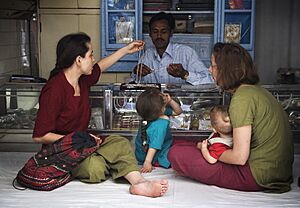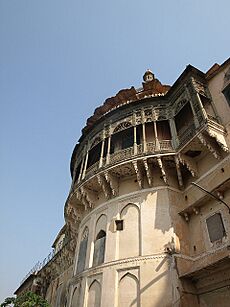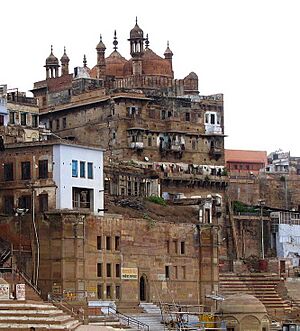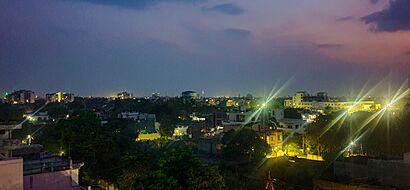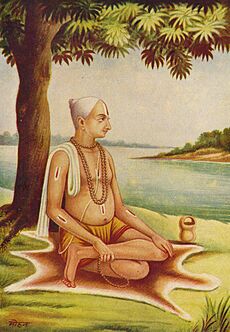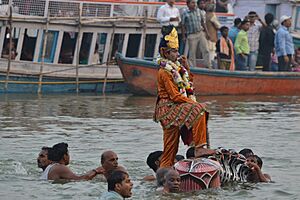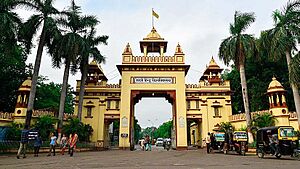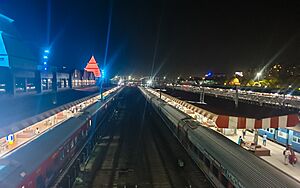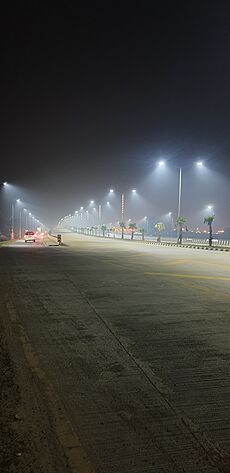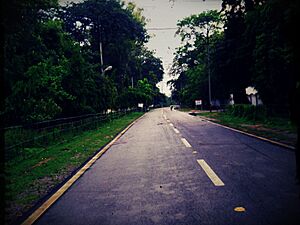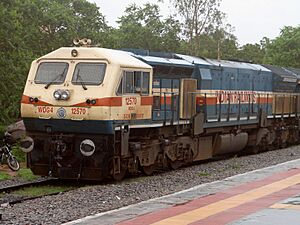Varanasi facts for kids
Quick facts for kids
Varanasi
Vārāṇasī
Benares, Banaras, Kashi
|
|
|---|---|
|
Left to right, top to bottom: Manikarnika Ghat, the holy cremation ground on the Ganges river front; Shehnai maestro Ustad Bismillah Khan; Faculty of Arts, Benares Hindu University; Goswami Tulsidas, composer of the Ramcharitmanas; weaving silk brocade; Benares Sanskrit College, India's oldest Sanskrit college (founded in 1791); and Munshi Ghat
|
|
| Nickname(s):
Religious Capital of India
|
|
| Country | |
| State | Uttar Pradesh |
| Division | Varanasi |
| District | Varanasi |
| Government | |
| • Type | Municipal Corporation |
| • Body | Varanasi Municipal Corporation |
| Area | |
| • Metropolis | 82 km2 (32 sq mi) |
| • Metro | 163.8 km2 (63.2 sq mi) |
| Elevation | 80.71 m (264.80 ft) |
| Population
(2011)
|
|
| • Metropolis | 1,212,610 |
| • Rank | 30th |
| • Density | 14,790/km2 (38,300/sq mi) |
| • Metro | 1,432,280 (32nd) |
| Demonym(s) | Banarasi |
| Language | |
| • Official | Hindi |
| • Additional official | Urdu |
| • Regional | Bhojpuri |
| Time zone | UTC+5:30 (IST) |
| PIN |
221 001 to ( area code)
|
| Telephone code | 0542 |
| Vehicle registration | UP-65 |
| GDP | $3.8 billion (2019–20) |
| Per capita income | INR 1,93 616 |
| International Airport | Lal Bahadur Shastri International Airport |
| Rapid Transit | Varanasi Metro |
| Sex ratio | 0.926 (2011) ♂/♀ |
| Literacy (2011) | 80.31% |
| HDI | 0.812 |
Varanasi (also known as Benares, Banaras, or Kashi) is an ancient city in northern India. It sits on the banks of the Ganges river. Varanasi is very important for Hindus as a place for pilgrimage, death, and mourning. The city is also known for its beautiful Islamic art and crafts, which attract many tourists.
Varanasi is located in the middle of the Ganges valley in the state of Uttar Pradesh. It is on the left side of the river. The city is about 692 kilometers (430 miles) southeast of India's capital, New Delhi. It is also 320 kilometers (199 miles) southeast of Lucknow, the state capital.
Varanasi is one of the world's oldest cities where people have lived without interruption. Its old name, Kashi, comes from a kingdom that existed 2,500 years ago. The Lion capital of Ashoka at nearby Sarnath is believed to mark the spot where the Buddha gave his first sermon around 500 BCE. In the 8th century, Adi Shankara made the worship of Shiva a main part of Varanasi's religious life.
Many important spiritual leaders were born or lived in Varanasi. Tulsidas wrote his famous epic, the Ramcharitmanas, here. This book is a version of the ancient Ramayana story. Other famous figures like Kabir and Ravidas were also born in Varanasi. In the 16th century, powerful nobles helped build and improve the main Shiva temple in the city.
Varanasi is famous for its silk weaving, carpets, and crafts. Tourism is also a big part of its economy. The city is known for its many ghats, which are steps leading down to the river. Pilgrims use these ghats for religious ceremonies. The Manikarnika Ghat and Harishchandra Ghat are special places where Hindus cremate their dead. Important temples include the Kashi Vishwanath Temple (dedicated to Shiva), the Sankat Mochan Hanuman Temple, and the Durga Temple.
The city has always been a center for education and music. Many famous Indian thinkers, poets, writers, and musicians have lived here. The Benares gharana style of Hindustani classical music was developed in Varanasi. In the 20th century, the writer Premchand and the shehnai player Bismillah Khan were connected to the city. India's oldest Sanskrit college, the Benares Sanskrit College, was founded in 1791. Later, Annie Besant and Madan Mohan Malviya helped create the Banaras Hindu University in 1916. This was India's first modern university where students could live on campus.
Contents
About Varanasi: A City of Light
What's in a Name?
The name "Varanasi" comes from two small rivers that flow into the Ganges. These are the Varuna River in the north and the Assi stream in the south. The old part of the city is located between these two rivers.
Another ancient name for the city is Kashi. This name comes from a Sanskrit word meaning "to shine." So, Varanasi is also known as the "City of Light." This name shows its importance as a place of learning and wisdom. Hindu texts also call Varanasi by other names, like "never forsaken by Shiva" and "the forest of bliss."
Varanasi's Ancient Stories
According to Hindu mythology, the god Shiva founded Varanasi. There's a story that a part of the god Brahma fell to the ground here, making it a very holy place.
The Pandavas, heroes from the Hindu epic Mahabharata, are said to have visited Varanasi. They came to seek Shiva's help to make up for their sins. Varanasi is one of seven holy cities that can help people achieve Moksha (spiritual liberation).
A Glimpse into the Past
Recent digs in 2014 found old items from as far back as 800 BCE. Other discoveries suggest people lived in this area around 1800 BCE.
When the Buddha lived, Varanasi was part of the Kingdom of Kashi. A Chinese traveler named Xuanzang visited in the 7th century. He wrote that Varanasi was a busy center for religion and art. He noted that the city had about 30 temples. In the 8th century, Adi Shankara helped make the worship of Shiva a main part of Varanasi's religious life.
Medieval Times
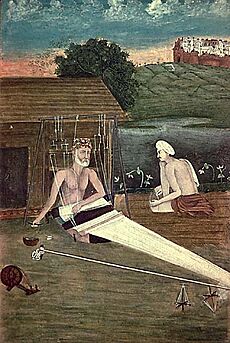
In 1090, the Gahadavala dynasty made Banaras their second capital. Later, in 1194 CE, a conqueror named Muizzuddin Muhammad Ghuri attacked the city. Many temples were destroyed during this time.
Varanasi remained a hub for thinkers and religious leaders during the Middle Ages. This helped it become known as a cultural and educational center. Many important figures of the Bhakti movement were born here. These include Kabir (born in 1389) and Ravidas, a spiritual leader from the 15th century.
From Old Empires to Modern India
{{gallery mode="packed" heights="150" File:Benares A Brahmin placing a garland on the holiest spot in the sacred city by James Prinsep 1832.jpg|A drawing from 1832 showing a Brahmin offering a garland in Varanasi. File:On The River Benares ca 1883.jpg|A painting from 1883 showing Varanasi from the Ganges river. File:Bathing Ghat Banaras India 1890.jpg|An illustration from 1890 of a bathing ghat in Varanasi. }} Many famous scholars and preachers visited Varanasi from all over India. Guru Nanak, who started Sikhism, visited in 1507.
In the 16th century, the Mughal emperor Akbar attacked Varanasi. However, later, Rajput rulers helped rebuild many temples and ghats in the city. The Raja of Jaipur built the Annapurna Mandir. The Akbari Bridge, 200 meters long, was also finished then. Early tourists started coming in the 16th century.
In 1656, Emperor Aurangzeb ordered many temples to be destroyed and mosques to be built. This caused a temporary setback for the city. But after Aurangzeb's death, Hindu kings ruled much of India. Most of modern Varanasi was built during this time, especially in the 18th century.
The Kingdom of Benares became official in 1737. It continued as a kingdom until India became independent in 1947. In the 18th century, an observatory was built on the Ganges to study the stars. Tourism grew in the city during this time.
In 1791, the British founded a Sanskrit College in Varanasi. In 1867, the Varanasi Municipal Board was set up. This led to big improvements in the city's services like health, water, and sanitation.
An author named Mark Twain wrote in 1897 that Varanasi was "older than history, older than tradition, older even than legend."
In 1911, Benares became a princely state with Ramnagar as its capital. The religious leader, Kashi Naresh, has lived at the Ramnagar Fort since the 18th century. Many locals believe he is an incarnation of Shiva.
Annie Besant started the Central Hindu School in 1898. She wanted to bring people of all religions together. This school later helped create the Banaras Hindu University in 1916.
Varanasi became part of Uttar Pradesh after India gained independence in 1947.
Varanasi Today
{{gallery mode="packed" heights="150" Majaraja of Benares and Suite, 1870s.jpg|Maharaja of Benares, 1870s. Benares (Baedeker, 1914).jpg|A map of the city from around 1914. Benares - riverfront - edit LCCN2004707379.jpg|An 1895 photo of the Varanasi riverfront. 20160628 021143293 iOS.jpg|The colorful lanes of Varanasi. }} Since 2014, Narendra Modi, the Prime Minister of India, has represented Varanasi in the Parliament of India. In 2021, Modi opened the Shri Kashi Vishwanath Corridor. This project connects many ghats to the Kashi Vishwanath temple, making the spiritual experience better.
What is Varanasi Like?
Geography and Weather
Varanasi is located about 80.71 meters (265 feet) above sea level. It is in the eastern part of Uttar Pradesh, along the crescent-shaped bank of the Ganges river. The city is between the Varuna and Assi rivers, which flow into the Ganges. The area is very fertile because the Ganges river floods regularly, adding nutrients to the soil.
Varanasi has a humid subtropical climate. This means there are big differences between summer and winter temperatures. Dry summers last from April to June, followed by the monsoon season from July to October. Summer temperatures can reach between 22 and 46 degrees Celsius (72 and 115 degrees Fahrenheit). Winters are cold at night but warm during the day. Temperatures can drop below 5 degrees Celsius (41 degrees Fahrenheit) in winter. The city gets about 1110 mm (44 inches) of rain each year. Fog is common in winter, and hot, dry winds called "loo" blow in summer.
| Climate data for Varanasi (1991–2020, extremes 1901–2012) | |||||||||||||
|---|---|---|---|---|---|---|---|---|---|---|---|---|---|
| Month | Jan | Feb | Mar | Apr | May | Jun | Jul | Aug | Sep | Oct | Nov | Dec | Year |
| Record high °C (°F) | 32.5 (90.5) |
36.1 (97.0) |
41.5 (106.7) |
45.3 (113.5) |
47.2 (117.0) |
47.2 (117.0) |
45.0 (113.0) |
40.1 (104.2) |
39.8 (103.6) |
39.4 (102.9) |
37.1 (98.8) |
32.8 (91.0) |
47.2 (117.0) |
| Mean daily maximum °C (°F) | 21.9 (71.4) |
26.7 (80.1) |
32.8 (91.0) |
38.9 (102.0) |
40.4 (104.7) |
38.5 (101.3) |
33.8 (92.8) |
33.1 (91.6) |
33.1 (91.6) |
32.5 (90.5) |
29.2 (84.6) |
24.1 (75.4) |
32.1 (89.8) |
| Mean daily minimum °C (°F) | 9.0 (48.2) |
12.4 (54.3) |
16.7 (62.1) |
22.1 (71.8) |
25.9 (78.6) |
27.8 (82.0) |
26.6 (79.9) |
26.2 (79.2) |
25.3 (77.5) |
20.9 (69.6) |
14.5 (58.1) |
10.1 (50.2) |
19.7 (67.5) |
| Record low °C (°F) | 1.0 (33.8) |
1.7 (35.1) |
6.7 (44.1) |
11.1 (52.0) |
17.3 (63.1) |
20.5 (68.9) |
20.0 (68.0) |
20.4 (68.7) |
16.4 (61.5) |
11.7 (53.1) |
5.0 (41.0) |
2.2 (36.0) |
1.0 (33.8) |
| Average rainfall mm (inches) | 16.3 (0.64) |
21.7 (0.85) |
10.8 (0.43) |
7.3 (0.29) |
13.8 (0.54) |
100.8 (3.97) |
265.2 (10.44) |
282.9 (11.14) |
224.5 (8.84) |
33.0 (1.30) |
5.5 (0.22) |
3.9 (0.15) |
985.9 (38.81) |
| Average rainy days | 1.5 | 1.7 | 1.2 | 0.8 | 1.4 | 5.2 | 12.3 | 12.9 | 8.6 | 1.9 | 0.3 | 0.3 | 48.1 |
| Average relative humidity (%) (at 17:30 IST) | 65 | 52 | 37 | 28 | 32 | 51 | 74 | 79 | 78 | 71 | 69 | 70 | 59 |
| Mean monthly sunshine hours | 232.5 | 240.1 | 291.4 | 294.0 | 300.7 | 234.0 | 142.6 | 189.1 | 195.0 | 257.3 | 261.0 | 210.8 | 2,848.5 |
| Mean daily sunshine hours | 7.5 | 8.5 | 9.4 | 9.8 | 9.7 | 7.8 | 4.6 | 6.1 | 6.5 | 8.3 | 8.7 | 6.8 | 7.8 |
| Average ultraviolet index | 6 | 7 | 10 | 11 | 12 | 12 | 12 | 12 | 11 | 8 | 6 | 5 | 9 |
| Source 1: India Meteorological Department (sun 1971–2000) | |||||||||||||
| Source 2: Weather Atlas | |||||||||||||
| Climate data for Varanasi Airport (1991–2020, extremes 1952–2012) | |||||||||||||
|---|---|---|---|---|---|---|---|---|---|---|---|---|---|
| Month | Jan | Feb | Mar | Apr | May | Jun | Jul | Aug | Sep | Oct | Nov | Dec | Year |
| Record high °C (°F) | 32.3 (90.1) |
35.8 (96.4) |
42.4 (108.3) |
46.7 (116.1) |
46.8 (116.2) |
48.0 (118.4) |
43.9 (111.0) |
39.8 (103.6) |
42.3 (108.1) |
39.0 (102.2) |
35.3 (95.5) |
32.7 (90.9) |
48.0 (118.4) |
| Mean daily maximum °C (°F) | 22.2 (72.0) |
26.9 (80.4) |
33.3 (91.9) |
39.3 (102.7) |
40.7 (105.3) |
38.9 (102.0) |
34.3 (93.7) |
33.3 (91.9) |
33.4 (92.1) |
33.1 (91.6) |
29.7 (85.5) |
24.4 (75.9) |
32.5 (90.5) |
| Mean daily minimum °C (°F) | 8.9 (48.0) |
12.2 (54.0) |
16.5 (61.7) |
21.9 (71.4) |
25.7 (78.3) |
27.5 (81.5) |
26.5 (79.7) |
26.1 (79.0) |
25.2 (77.4) |
21.0 (69.8) |
14.8 (58.6) |
10.2 (50.4) |
19.8 (67.6) |
| Record low °C (°F) | 0.3 (32.5) |
2.4 (36.3) |
4.0 (39.2) |
11.4 (52.5) |
17.8 (64.0) |
14.3 (57.7) |
21.4 (70.5) |
21.5 (70.7) |
19.1 (66.4) |
8.9 (48.0) |
4.3 (39.7) |
2.3 (36.1) |
0.3 (32.5) |
| Average rainfall mm (inches) | 14.2 (0.56) |
19.3 (0.76) |
9.4 (0.37) |
10.3 (0.41) |
16.7 (0.66) |
108.8 (4.28) |
293.7 (11.56) |
259.3 (10.21) |
206.9 (8.15) |
30.6 (1.20) |
4.8 (0.19) |
2.7 (0.11) |
976.8 (38.46) |
| Average rainy days | 1.4 | 1.5 | 0.8 | 0.8 | 1.6 | 5.3 | 12.5 | 12.4 | 8.5 | 1.8 | 0.4 | 0.4 | 47.3 |
| Average relative humidity (%) (at 17:30 IST) | 64 | 52 | 36 | 24 | 30 | 49 | 73 | 78 | 76 | 65 | 61 | 66 | 56 |
| Source: India Meteorological Department | |||||||||||||
People of Varanasi
In 2011, the Varanasi urban area had about 1.4 million people. The city itself had about 1.2 million residents. About 70% of the people in Varanasi follow Hinduism. Islam is the largest minority religion. The city also has followers of Christianity, Sikhism, Jainism, and Buddhism. Varanasi is a major place for Buddhist pilgrims because the Buddha gave his first teaching in Sarnath, just northeast of the city.
Varanasi is sometimes called the "microcosm of India" because it has so many different religions. Besides its many Hindu temples, it has churches, Jain temples, Buddhist shrines, Sikh gurdwaras, and Muslim holy places.
Languages Spoken
Most people in Varanasi speak Hindi as their first language (about 83.87%). Other languages spoken include Urdu (9.03%) and Bhojpuri (4.81%).
Varanasi's Economy
About 29% of Varanasi's population has jobs. Many work in manufacturing (40%) and trade (26%).
Industries and Crafts
Silk weaving is the most important industry in Varanasi. Many people, especially Momin Ansari Muslims, work as weavers, dyers, and sellers of silk. Varanasi is famous for its very fine silk and Banarasi saris. These saris are often used for weddings and have gold and silver thread work.
Other important products made and sold in Varanasi include hand-knotted carpets, rugs, brassware, wooden toys, and musical instruments.
Tourism in Varanasi
Tourism is the second biggest industry in Varanasi. Many Indian tourists visit for religious reasons. Foreign tourists come to see the ghats along the Ganges River and Sarnath. Most foreign visitors are from Sri Lanka and Japan. The busiest tourist season is from October to March.
Places to See in Varanasi
{{Wide image|Varanasi panorama.jpg|880px|A wide view of the Ghats in Varanasi from the Ganges river.]] Varanasi has many interesting places to visit. These include ancient sites, temples, mosques, and forts.
Jantar Mantar Observatory
The Jantar Mantar observatory was built in 1737. It is located above the ghats along the Ganges. This observatory has a special sundial that can be used to measure time.
Ramnagar Fort
The Ramnagar Fort is on the eastern bank of the Ganges. It was built in the 18th century using cream-colored sandstone. The fort looks like typical Mughal architecture with carved balconies and open courtyards. Today, the fort and its museum hold the history of the kings of Benares. The museum has old cars, fancy chairs, weapons, and an astrological clock.
Riverfront Ghats
The Ghats in Varanasi are famous stone steps along the river bank. Pilgrims use them for religious baths and ceremonies. Varanasi has at least 84 ghats. Most are for bathing, while a few are used for Hindu cremations. The steps lead down to the Ganges. Important ghats include the Dashashwamedh Ghat, Manikarnika Ghat, and Harishchandra Ghat. Many ghats have Hindu legends connected to them. A boat ride on the Ganges in the morning, past the ghats, is a popular activity for tourists.
- The Dashashwamedh Ghat is the main and oldest ghat in Varanasi. It is near the Kashi Vishwanath Temple. People believe that the god Brahma created this ghat to welcome Shiva. Every evening, priests perform a fire worship ceremony here.
- The Manikarnika Ghat is the main place for Hindu cremations in the city. According to a myth, an earring of Shiva or his wife Sati fell here. This ghat has been rebuilt several times since 1302.
- The Jain Ghat is also known as Bachraj Ghat. It is believed to be the birthplace of Suparshvanatha and Parshvanatha, two important Jain spiritual leaders. This ghat has three Jain Temples near the river.
{{gallery mode="packed" caption="Ghats in Varanasi" heights="150" File:Dashawamedha Ghat in Varanasi 2.jpg|Dashashwamedh Ghat. File:Manikarnika Cremation Ghat, Varanasi.jpg|Manikarnika Ghat. File:Jain Ghat, Varanasi, UP, India.jpg|The Jain Ghat/Bachraj Ghat. File:People_of_Varanasi_26.jpg|Kedar Ghat during Kartika Purnima. }}
Famous Temples
{{gallery mode="packed" heights="150" File:Benares- The Golden Temple, India, ca. 1915 (IMP-CSCNWW33-OS14-66).jpg|The Kashi Vishwanath Temple, a very important temple in Varanasi. File:New Vishwanath Temple at BHU.jpg|Shri Vishwanath Mandir has one of the tallest temple towers in the world. File:Durga Mandir, Varanasi, Uttar Pradesh, India (2007).jpg|The 18th century Durga Kund Temple. File:Bhelupur Shwetambar temple (1).jpg|Parshvanath Jain temple. }} Varanasi has thousands of temples. The most popular ones are the Kashi Vishwanath Temple, the Sankat Mochan Hanuman Temple, and the Durga Temple.
- The Kashi Vishwanath Temple is one of the 12 most important Shiva temples in Varanasi. It is also called the Golden Temple. It was built in 1780. The two tall parts of the temple are covered in gold.
- The Sankat Mochan Hanuman Temple is dedicated to the Hindu god Hanuman. The current temple was built in the early 1900s by Pandit Madan Mohan Malaviya. People believe it was built where the saint Tulsidas saw Hanuman.
- The Durga Mandir was built in the 16th century. It is known for the monkeys that live in the nearby trees. Many Hindu devotees visit during Navratri to worship the goddess Durga. The temple is red, representing Durga's color. It has a rectangular pool of water called the Durga Kund.
- Parshvanath Jain temple is a Jain temple dedicated to Parshvanath. He was the 23rd Tirthankara and was born in Varanasi.
Important Mosques
Varanasi has 15 mosques that are historically important. Two well-known ones are the Gyanvapi Mosque and the Alamgir Mosque.
- The Gyanvapi Mosque was built by the Mughal emperor Aurangzeb in 1664 CE. Its name, Gyan Vapi, means "the well of knowledge." Parts of an older temple can be seen in its foundation.
- The Alamgiri Mosque was also built by Aurangzeb in the 17th century. It is located above the Panchganga Ghat. The mosque mixes Islamic and Hindu architectural styles.
Shri Guru Ravidass Janam Asthan

Shri Guru Ravidass Janam Asthan is a very important pilgrimage site for followers of the Ravidassia religion. It is located at the birthplace of Ravidas. The temple was finished in 1994.
Sarnath: Where Buddha Taught
Sarnath is about 10 kilometers (6 miles) northeast of Varanasi. It is famous because Gautama Buddha gave his first teaching here after becoming enlightened. This is where the Buddhist Sangha (community) began. The Buddha himself said Sarnath was one of the four most important places for his followers to visit.
Varanasi's Rich Culture
Literature and Writers
Varanasi has been home to many famous Indian writers. These include Kabir, Ravidas, and Tulsidas. Tulsidas wrote much of his Ram Charit Manas here. Later writers like Premchand and Hazari Prasad Dwivedi also lived in the city.
Newspapers are widely available in Hindi and English. Aj, a Hindi newspaper, started in Varanasi in 1920.
Art and Music
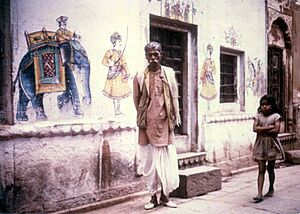
Varanasi is a big center for arts and designs. It is known for its silks, brocades with gold and silver threads, carpets, wooden toys, and perfumes.
Many famous musicians and dancers are connected to the city. These include Bismillah Khan (a shehnai player) and Ravi Shankar (a sitar player). Varanasi is recognized by UNESCO as a "City of Music."
Varanasi's music history goes back to ancient times. The god Shiva is believed to have created music and dance forms. In the medieval period, the Bhakti movement made Varanasi a lively place for musicians like Surdas, Kabir, and Tulsidas.
Festivals and Celebrations
Varanasi celebrates many festivals throughout the year.
- On Maha Shivaratri (February), a procession of Shiva goes from one temple to another.
- The Dhrupad Mela is a five-day music festival held in February–March.
- The Sankat Mochan Hanuman Temple celebrates Hanuman Jayanti (March–April). A special music and dance festival is held here every year.
- The Ramlila of Ramnagar is a play about the legend of Rama. It is performed for 31 days every evening.
- Chhath Puja is celebrated in October–November. People offer prayers to the sun god.
- Nag Nathaiya is celebrated in October–November. It remembers Krishna's victory over the serpent Kaliya. A boy plays Krishna and jumps into the river onto a model of Kaliya.
- Bharat Milap celebrates the meeting of Rama and his brother Bharata. It is celebrated in October–November.
- Ganga Mahotsav is a five-day music festival in November–December. Thousands of pilgrims release lighted lamps into the Ganges river.
- Muslim festivals like Eid al-Fitr and Eid al-Adha are also celebrated.
Learning and Education
Varanasi has always been a center for education in India. It attracts students and scholars from all over the country. The city has a high literacy rate of 80%.
Varanasi is home to many colleges and universities. The most famous is Banaras Hindu University (BHU). It is one of the largest universities in Asia with over 20,000 students. The Indian Institute of Technology (BHU) Varanasi is a very important engineering school.
Other important colleges include Mahatma Gandhi Kashi Vidyapith and Sampurnanand Sanskrit University. There are also research institutes like the International Rice Research Institute.
Schools in Varanasi follow different education boards. Some are private schools, and some are government schools.
Media and Entertainment
Varanasi is a popular place for filming movies and TV shows in India. Many Hindi and South Indian films, as well as Bhojpuri movies, are shot here. Even parts of the Hollywood movie The Curious Case of Benjamin Button were filmed in Varanasi.
Newspapers like Dainik Jagran and The Times of India are widely available. The city also has several radio stations.
Sports and Recreation
Basketball, cricket, and field hockey are popular sports in Varanasi. The main stadium is the Dr Sampurnanda Stadium, where cricket matches are played. There is also a hockey stadium.
The Banaras Hindu University offers courses in sports management and sports psychology. Many girls practice Gymnastics outdoors at the ghats. The city also has swimming clubs.
Getting Around Varanasi
Air Travel
Varanasi is served by Lal Bahadur Shastri International Airport. It is about 26 kilometers (16 miles) from the city center. The airport became an international airport in 2012.
Train Travel
Varanasi Junction is the city's largest train station. More than 360,000 passengers and 240 trains pass through it every day. Banaras railway station is another important station. There are also other stations like Varanasi City railway station and Kashi railway station.
Trains like the Vande Bharat Express connect Varanasi to other major cities like New Delhi.
Roads and Local Transport
Inside the city, you can get around using taxis, rickshaws, and three-wheelers. City buses run on specific routes.
Several national highways pass through Varanasi, connecting it to other cities in India. The city also has a smart traffic management system to help traffic flow smoothly.
Waterways
National Waterway 1 passes through Varanasi. In 2018, a new inland port was built on the Ganges River. This port helps move goods by water.
Future Projects
Varanasi is undergoing many new projects to improve its infrastructure. These projects are in different sectors like roads, railways, and urban development.
Road Projects
The government is building many new roads around Varanasi. These include six-lane highways and ring roads to ease traffic.
Railway Projects
New railway projects include adding more train lines and developing stations. The Kashi Railway Station will become a major transport hub.
Airport Improvements
The airport runway is being extended. A new terminal is also being built to handle more passengers.
Varanasi Metro
A metro system is planned for Varanasi. It will have two lines and 26 stations, mostly underground. This will help people travel faster across the city.
New Commercial Developments
New projects include a convention center, a freight village, and a film city. There are also plans for a bus terminal with a shopping mall and an IT Park.
Sister Cities
Varanasi has sister city relationships with:
Images for kids
See also
 In Spanish: Benarés para niños
In Spanish: Benarés para niños









